

What will the influence be on apple growing if our climate gets warmer?
Last Saturday The English Apple Man joined invited guests for the formal opening of Apples in a Warmer World by Faversham MP Helen Whately.
The National Fruit Collection Trust has created and supported the "Apples in a Warmer World" lon-term climate change apple production impact project to:
* provide professional and amateur fruit growers, breeders, pomologists and the supply chain with information on how apples might respond to possible climate change scenarios in the UK
* improve our understanding of how these possible climate scenarios might impact on other perennial tree fruit crops
* provide a research facility and encourage engagement with the scientific community.
The experimental facility covers 0.6 hectares and consists of a triple-span tunnel. The 15 varieties of trees were established in 2014 and cover a mix of early, mid or late flowering/fruiting varieties with a pollination group mix. The varieties also provide a mix of traits.
The Trustees of the National Fruit Collections Trust are hoping for at least a 10 year life for the climate change research and seeking to find the change in quality and nutritional benefits, reflecting on warmer climates overseas Professor Richard Ellis said its not just about temperature, we cannot just take the temperature curve in the South of France or Northern Italy, solar radiation is different and the reaction of traditional UK varieties and the global varieties in the warmer climate, plus the effect of pest and disease, will, we hope not just be a scientific experiment, but one which informs UK growers on the varieties for the future and management practices required.
University of Reading Professor Richard Ellis - Chair of the National Fruit Collections Trust explains the objectives of the new facility
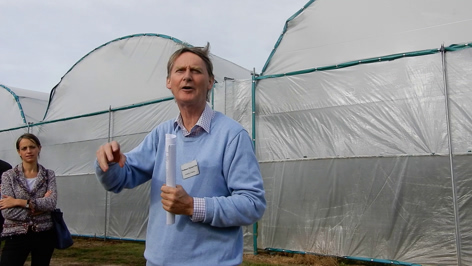
Below: University of Reading Professor Paul Hadley explains the mechanics of the new research facilty
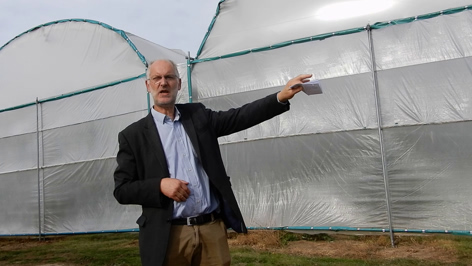 Professor Paul Hadley said we know a lot about the past and the change in climate to date: what we need to find out is the probability for future change in the climate. Over the 40 year life of the Fruit Collection the temperature has risen across a year and the flowering date for the whole collection (average) is now 17 days earlier than back in the 1960's
Professor Paul Hadley said we know a lot about the past and the change in climate to date: what we need to find out is the probability for future change in the climate. Over the 40 year life of the Fruit Collection the temperature has risen across a year and the flowering date for the whole collection (average) is now 17 days earlier than back in the 1960's
So rather than looking back, we are planning to look forward and try to project the influence on our trees over the next 50-60 years. So we have 3 multispan tunnels. with one at ambient, one at 2c above ambient and one at 4c above ambient.
We are fortunate to benefit from advances in technology: for instance Haygrove Tunnels created an automatic venting system which opens and closes the window/vents in relation to the ambient temperature curve.
Below: the tunnel gutter catch the rainfall which is piped to the adjacent reservoir
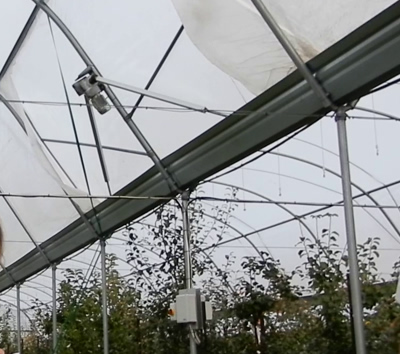 Within the 3 temperature zones are 3 irrigation modules, so there are 9 different climate environments.
Within the 3 temperature zones are 3 irrigation modules, so there are 9 different climate environments.
All the rainfall is collected from the roof of the tunnels via gutters and piped to a large reservoir, the rainfall is measured and the rainfall curve determines how much water is applied to the 3 modules.
Module 1. Normal: The irrigation system delivers water equivalent to the 'rainfall curve' outside delivering water at the same rate as the outside weather pattern.
Module 2. Wet: The second irrigation module delivers 20% more than the 'normal' rainfall.
Module:3. Dry: The 3rd module delivers 20% less water than normal rainfall.
Below: The reservoir adjacent to the Triple span tunnels.
Paul Hadley said: "I am very grateful to Haygrove for providing the tunnel structures and venting technology and our thanks to BPI for the polythene covers.
After the introductions by Richard Ellis and Paul Hadley, the "Apples in a Warmer World" facility was formally opened by Faversham MP Helen Whatley.
Below: Faversham MP Helen Whatley cuts the ribbon to formally open the Apples in a Warmer World research facility
Tim Biddlecombe - Secretary National Fruit Collections Trust explained the effects of trees growing in the 3 temperature zones. Increased vegetative growth, increased pest and disease challenges, much earlier blossom, earlier cropping: the Gala in the +4c tunnels was ready for harvest 3-4 weeks earlier than in in orchards outside.
Tim said: you may wonder why we have created an ambient tunnel; the reason is we are able to research the three irrigation modules in all three climate zones. The ambient tunnel is kept as close a possible to the 'outside temperature curve' which is recorded to ensure accurate alignment.
Tim said "you will have noticed a few gaps" this is because some varieties have succumbed to Canker; "not surprising as the higher temperature and above normal rainfall (irrigation) creates conditions conducive to canker" - We intend to replace with some more varieties: Granny Smith is a candidate, with the variety normally maturing at least 10 days after Braeburn (which is now grown successfully in the UK) so the climate change may allpw Granny Smith to be successfully grown here in the future. Tim said there are some small areas of Granny being grown in th UK but only on 'early sites' in Kent.
Below: left; Tim Biddlecombe and a 'very attentive' John Warner - Master of The Worshipful Company of Fruiterers in the tunnels and right; NIAB EMR Managing Director, Professor Mario Caccamo, AHDB Communications Director Scott Raffle and Tim Biddlecombe
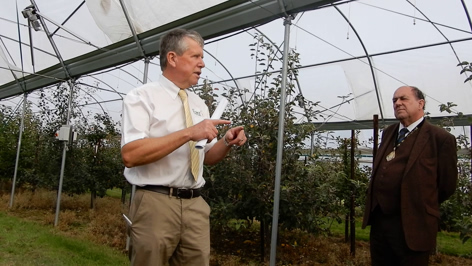
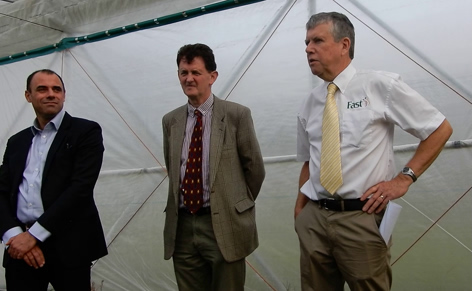
Woolly aphids is a problem in many commercial orchards and the experience of just one season in the research facility, demonstrates the susceptibility of some varieties to woolly aphids in a higher temperature/humidity environment.
Below: left; a badly infested tree with woolly aphids and right; a comparison of 2 varieties 'side by side' one badly infested and the other clear
Below: Will Sibley former trustee of East Malling Trust and a former Master of The Worshipful Company of Fruiterers; on behalf of the NFC Trustees thanked Helen Whatley for her support in opening the facility today; Will also thanked FAST and the farm manager Nigel Baker and the sponsors and many benefactors and agencies involved in the establishment of this exciting research facilty
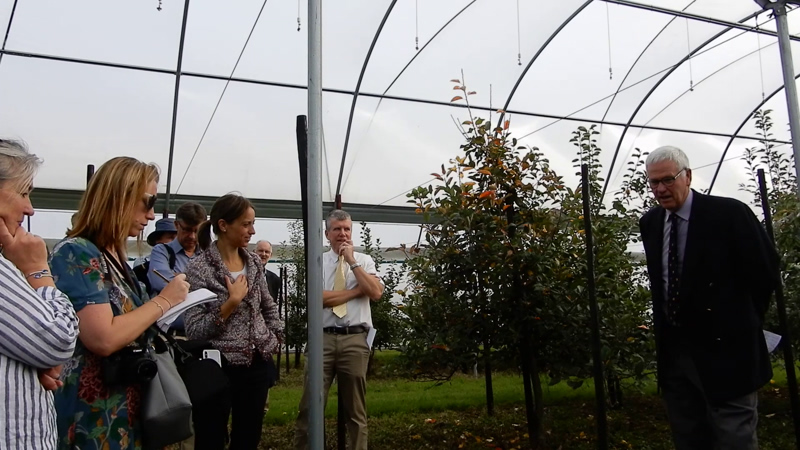
Below: a group picture of the participants in the "Apples in a Warmer World" project
Below: left; On my way back to the Brogdale Apple Festival which was held at the weekend, a picture of a very well laden apple tree in the National Fruit Collection and right; part of the National Fruit Collection display of apples
Below: The apple display was held in a large barn at Brogdale - there are circa 2,400 varieties of apple in the collection
![]() That's all for this week. Next week is the National Fruit Show 85th Anniversary event and The English Apple Man will report on the show in Friday 26th October Journal - the next day my wife, and daughter fly with me to Malta for our annual sojourn.
That's all for this week. Next week is the National Fruit Show 85th Anniversary event and The English Apple Man will report on the show in Friday 26th October Journal - the next day my wife, and daughter fly with me to Malta for our annual sojourn.
Take care
The English Apple Man